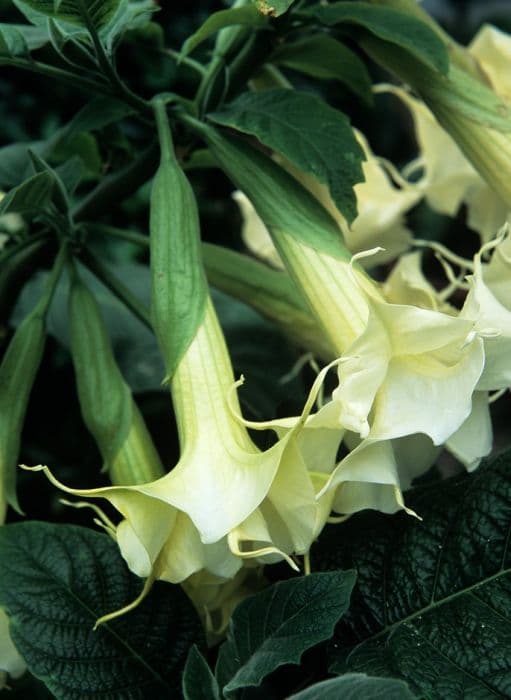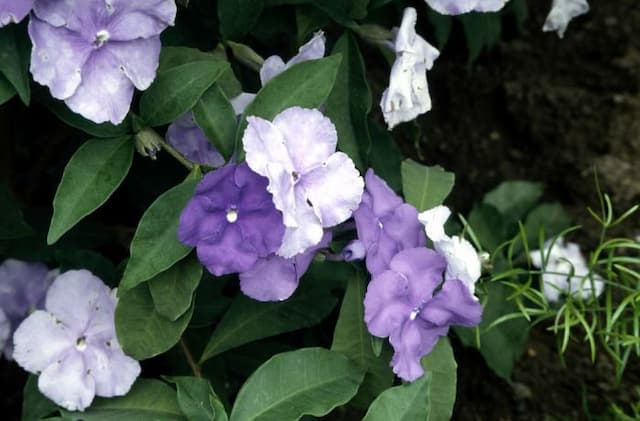Malevolence Solanum atropurpureum

ABOUT
The plant known as Malevolence is a unique and striking species characterized by its deep purple, almost black stems that are thorny, giving it a somewhat menacing appearance. The leaves of Malevolence are large and lobed, with a dark green color and purple veins that are quite prominent. Each leaf has a textured surface and may have a slight hairy appearance on the undersides. Flowering on this plant are the blooms which can vary in color from white to light purple, adding a vivid contrast against the dark foliage. The flowers are star-shaped and are borne in clusters, which makes them quite decorative. The center of each flower is often yellow or a bright contrasting color, containing reproductive parts which are visible in the detailed structure of the bloom. The berry-like fruits which follow are initially green, turning yellow as they mature. These spherical fruits are small and contain seeds which are enclosed in the fleshy interior of the berry, but take care as all parts of Malevolence, especially the fruits, are toxic and should not be ingested. Overall, the Malevolence plant has a robust and wild appearance, with a color palette that is strikingly dark yet accented with lighter tones in its blooms, making it a distinctive addition to any collection that prioritizes unusual and ornamental plants.
About this plant
 Names
NamesFamily
Solanaceae
Synonyms
Malevolence, Purple Devil, Five-Minute Plant
Common names
Solanum atropurpureum Schrank, Solanum pyrrhocarpum Dunal, Solanum sanctaerosae Vell.
 Toxicity
ToxicityTo humans
Malevolence, which is another name for Solanum atropurpureum, contains toxic compounds including solanine, which can be harmful if ingested by humans. Poisoning symptoms typically include nausea, vomiting, diarrhea, abdominal pain, and in severe cases, it can cause central nervous system effects such as drowsiness, confusion, or even convulsions. Chronic exposure or high doses may lead to more serious health issues like respiratory problems or cardiac effects. It is essential to avoid consuming any part of the malevolence plant due to its potent toxicity.
To pets
Malevolence, or Solanum atropurpureum, is toxic to pets just as it is to humans. This plant contains solanine and other toxic alkaloids that can affect a pet if ingested. Symptoms of poisoning in pets may include vomiting, diarrhea, abdominal pain, lethargy, weakness, confusion, and in severe cases, may progress to neurological symptoms such as tremors or seizures. It's crucial to prevent pets from having access to any part of the malevolence plant due to its potential to cause serious health complications or even death if consumed in enough quantity.
 Characteristics
CharacteristicsLife cycle
Perennials
Foliage type
Deciduous
Color of leaves
Green
Flower color
Purple
Height
4 feet [1.22 meters]
Spread
3 feet [0.91 meters]
Plant type
Shrub
Hardiness zones
10
Native area
Brazil South America
Benefits
 General Benefits
General Benefits- Ornamental Value: Solanum atropurpureum, commonly known as the Malevolence plant, has an attractive and exotic appearance with its spiny stems and dark foliage, making it a unique addition to gardens.
- Wildlife Attraction: Its flowers and fruits can attract insects and birds, providing food sources and facilitating pollination in the garden ecosystem.
- Drought Tolerance: Well-adapted to dry conditions, it can survive in areas with water scarcity, reducing the need for frequent watering.
- Soil Improvement: As a member of the nightshade family, it can help in improving soil health by adding organic matter when it decomposes.
- Windbreak: The dense and thorny nature of the plant can act as a windbreak, protecting more delicate plants in the garden from strong winds.
- Privacy Screen: Its growth habit can provide a natural and visually intriguing privacy screen in gardens and yards.
 Medical Properties
Medical Properties- Analgesic: Solanum atropurpureum, commonly known as malevolence, has been used in traditional medicine for its potential pain-relieving properties.
- Anti-inflammatory: The plant may have been used to reduce inflammation, although the scope and efficacy of this use are not fully researched or validated.
- Wound healing: There are claims that malevolence has been applied to wounds to promote healing, although scientific support for this use is lacking.
- Antimicrobial: Some studies have suggested that extracts from Solanum atropurpureum could possess antimicrobial properties against certain pathogens.
 Air-purifying Qualities
Air-purifying QualitiesThis plant is not specifically known for air purifying qualities.
 Other Uses
Other Uses- Solanum atropurpureum, also known as Malevolence, has been used as a natural barrier or fencing material due to its spiny stems which deter animals and humans from crossing into an area.
- The dense and thorny branches of Malevolence make it an effective anti-burglar plant when planted beneath windows or along property boundaries.
- In some cultures, Malevolence is used in traditional ceremonies or as a symbol due to its striking appearance and formidable thorns.
- Because of its unique aesthetic, Malevolence is sometimes used in ornamental horticulture for creating visually interesting landscapes or garden features.
- The fruit of Malevolence may be used to make natural dyes for coloring fabrics or artworks, although this is not a common practice.
- Malevolence branches have been used to craft handmade tools or weapons, with their hard stems providing a sturdy base material.
- Interest in entomology may lead to the use of Malevolence plants to study the insects that are attracted to or deterred by its presence.
- Due to its rapid growth and dense foliage, Malevolence can be employed as a quick-growing privacy screen in gardens and backyards.
- Some gardeners use Malevolence as companion planting to protect more vulnerable plants from pests and animals due to its natural defensive properties.
- Malevolence has been utilized in landscaping for soil erosion control, as its roots help to stabilize the soil and its thorns discourage foot traffic.
Interesting Facts
 Feng Shui
Feng ShuiThe Malevolence is not used in Feng Shui practice.
 Zodiac Sign Compitability
Zodiac Sign CompitabilityThe Malevolence is not used in astrology practice.
 Plant Symbolism
Plant Symbolism- Mystery and Witchcraft: As a member of the nightshade family, Solanum atropurpureum, commonly known as the Malevolence plant, often represents the mysterious and sometimes dark aspects of nature; it is sometimes associated with witchcraft and the occult due to its poisonous qualities and eerie appearance.
- Protection: Some cultures have used the thorny aspect of the Malevolence plant to symbolize protection, as the thorns are a physical barrier that can discourage negative forces or energies.
- Boundary Setting: The sharp spikes of the Malevolence plant can represent the need to set boundaries, symbolizing personal space and the defense of one's territory against unwanted intrusion.
 Water
WaterMalevolence plants should be watered deeply to ensure that the water reaches the roots, but overwatering must be avoided to prevent root rot. It’s ideal to water these plants when the top inch of soil feels dry to the touch, which could be approximately every week during active growth periods. Depending on the plant size and pot volume, you may need about half to one gallon of water during each watering session. Seasonal changes and indoor humidity levels play a role, so in winter, water less frequently. Ensure that the pot has good drainage to prevent water accumulation at the base.
 Light
LightThe Malevolence plant thrives best in full sunlight to partial shade conditions. It prefers a bright spot where it receives at least six hours of direct sunlight daily. However, it can tolerate moderate shade, especially in hot climates. When indoors, a south-facing window is often the most suitable location to provide the light intensity it requires.
 Temperature
TemperatureThe Malevolence plant grows well in temperatures between 60 and 85 degrees Fahrenheit. These plants can handle brief drops below 50 degrees Fahrenheit but should be protected from frost. For optimal growth, maintain a steady temperature within the preferred temperature range, avoiding sudden fluctuations that may stress the plant.
 Pruning
PruningPruning the Malevolence plant promotes healthy growth, removes dead or damaged branches, and maintains a desirable shape. Prune the plant in late winter or early spring, just before the onset of new growth. It’s not necessary to prune this plant often, an annual check is usually enough, but any problematic branches can be removed throughout the year.
 Cleaning
CleaningAs needed
 Soil
SoilFor the Malevolence plant, a rich, well-draining soil mix is ideal. Incorporate compost or aged manure to enrich the soil. Aim for a slightly acidic to neutral pH between 6.0 and 7.0 for optimal growth.
 Repotting
RepottingMalevolence plants should be repotted every 2-3 years to refresh the soil and encourage healthy growth. Use a larger pot to accommodate root expansion.
 Humidity & Misting
Humidity & MistingMalevolence plants prefer moderate to high humidity levels, around 40-70%. Ensure adequate air circulation to prevent fungal diseases.
 Suitable locations
Suitable locationsIndoor
Use bright, indirect light and well-draining soil.
Outdoor
Plant in partial shade and protect from strong winds.
Hardiness zone
9-11 USDA
 Life cycle
Life cycleSolanum atropurpureum, commonly known as Malevolence, begins its life cycle when its seeds germinate in warm, moist soil, typically in late spring or early summer. The seedlings develop true leaves and a root system, and as they mature, they form a bushy shrub with characteristic purplish, spiny stems and foliage. After vegetative growth, the plant enters the flowering stage; small, star-shaped flowers, often white or purplish, emerge and are pollinated by insects. Following pollination, the flowers develop into round, berry-like fruits that start green and ripen to a dark color, containing numerous seeds. When the fruits are fully ripe, they are dispersed by various means, including animals and gravity, starting the life cycle anew. Throughout the growing season, Malevolence can spread aggressively if conditions are favorable, and it may require several years to reach full maturity.
 Propogation
PropogationPropogation time
Spring-summer
Solanum atropurpureum, commonly known as malevolence, is mostly propagated through its seeds. The ideal time for sowing seeds is in the late winter or early spring when temperatures start to warm. To propagate by seeds, they should be sown in a well-draining soil mix, lightly covered and kept moist. Germination can be improved by providing bottom heat, in the range of around 70-75 degrees Fahrenheit (21-24 degrees Celsius), which encourages sprouting. Once seedlings have developed true leaves and are large enough to handle, they can be transplanted into individual pots before ultimately being moved outdoors when the danger of frost has passed.


![Calibrachoa [Callie Mango]](/_next/image?url=https%3A%2F%2Fplants-admin.emdemapps.com%2Fimages%2Fplants%2F%2Fimages%2F604b6514b1579.png&w=640&q=75)






